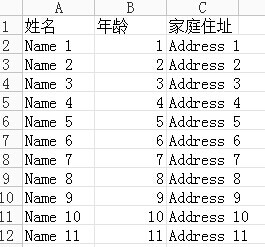ASP.NET MVC 将IList<T>导出Excel文档的泛型类(继承自ActionResult)
最近MVC项目中要使用到Excel导出功能,在网上找了些资料,自己写了一个通用的泛型类(ExcelResult)。因为是直接继承自ActionResult这个抽象类的,所以用起来很方便,在控制器的Action中直接实例化返回即可。本人的代码功底不是很好,写的代码有点烂,希望大伙指正。
废话少说,直接上类完整代码:
/// <summary>
/// 提供将泛型集合数据导出Excel文档。
/// </summary>
/// <typeparam name="T"></typeparam>
public class ExcelResult<T> : ActionResult where T : new()
{
public ExcelResult(IList<T> entity, string fileName, bool showDisplayName = true)
{
this.Entity = entity;
this.FileName = fileName;
this.ShowDisplayName = showDisplayName;
}
public ExcelResult(IList<T> entity, bool showDisplayName = true)
{
this.Entity = entity;
DateTime time = DateTime.Now;
this.FileName = string.Format("{0}_{1}_{2}_{3}",
time.Month, time.Day, time.Hour, time.Minute);
this.ShowDisplayName = showDisplayName;
}
public IList<T> Entity
{
get;
set;
}
public string FileName
{
get;
set;
}
public bool ShowDisplayName
{
get;
set;
}
public override void ExecuteResult(ControllerContext context)
{
if (Entity == null)
{
new EmptyResult().ExecuteResult(context);
return;
}
SetResponse(context);
}
/// <summary>
/// 设置并向客户端发送请求响应。
/// </summary>
/// <param name="context"></param>
private void SetResponse(ControllerContext context)
{
StringBuilder sBuilder = ConvertEntity();
byte[] bytestr = Encoding.Unicode.GetBytes(sBuilder.ToString());
context.HttpContext.Response.Clear();
context.HttpContext.Response.ClearContent();
context.HttpContext.Response.Buffer = true;
context.HttpContext.Response.Charset = "GB2312";
context.HttpContext.Response.ContentEncoding = Encoding.GetEncoding("GB2312");
context.HttpContext.Response.ContentType = "application/ms-excel";
context.HttpContext.Response.AddHeader("Content-Disposition", "attachment; filename=" + FileName + ".xls");
context.HttpContext.Response.AddHeader("Content-Length", bytestr.Length.ToString());
context.HttpContext.Response.Write(sBuilder);
context.HttpContext.Response.Flush();
context.HttpContext.Response.Close();
context.HttpContext.Response.End();
}
/// <summary>
/// 把泛型集合转换成组合Excel表格的字符串。
/// </summary>
/// <returns></returns>
private StringBuilder ConvertEntity()
{
StringBuilder sb = new StringBuilder();
AddTableHead(sb);
AddTableBody(sb);
return sb;
}
/// <summary>
/// 根据IList泛型集合中的每项的属性值来组合Excel表格。
/// </summary>
/// <param name="sb"></param>
private void AddTableBody(StringBuilder sb)
{
if (Entity == null || Entity.Count <= 0)
{
return;
}
PropertyInfo[] properties = typeof(T).GetProperties();
if (properties.Length <= 0)
{
return;
}
for (int i = 0; i < Entity.Count; i++)
{
for (int j = 0; j < properties.Length; j++)
{
string sign = j == properties.Length - 1 ? "\n" : "\t";
object obj = properties[j].GetValue(Entity[i], null);
sb.Append(obj ?? string.Empty).Append(sign);
}
}
}
/// <summary>
/// 根据指定类型T的所有属性名称来组合Excel表头。
/// </summary>
/// <param name="sb"></param>
private void AddTableHead(StringBuilder sb)
{
PropertyInfo[] properties = typeof(T).GetProperties();
if (properties.Length <= 0)
{
return;
}
for (int i = 0; i < properties.Length; i++)
{
string headName = properties[i].Name;
string sign = i == properties.Length - 1 ? "\n" : "\t";
if (!ShowDisplayName)
{
sb.Append(headName).Append(sign);
continue;
}
Attribute attribute = Attribute.GetCustomAttribute(properties[i], typeof(DisplayNameAttribute));
if (attribute != null)
{
DisplayNameAttribute displayNameAttribute = attribute as DisplayNameAttribute;
if (displayNameAttribute != null && !string.IsNullOrWhiteSpace(displayNameAttribute.DisplayName))
{
headName = displayNameAttribute.DisplayName;
}
}
sb.Append(headName).Append(sign);
}
}
}
在控制器中调用方法:
public ActionResult Index()
{
List<Student> students = new List<Student>();
for (int i = 1; i <= 100; i++)
{
students.Add(new Student
{
Name = "Name " + i.ToString(),
Age = i,
Address = "Address " + i.ToString()
});
}
return new ExcelResult<Student>(students);
}
上面代码中用到的Student类定义:
public class Student
{
[DisplayName("姓名")]
public string Name { get; set; }
[DisplayName("年龄")]
public int Age { get; set; }
[DisplayName("家庭住址")]
public string Address { get; set; }
}
结果导出的Excel文档截图:



